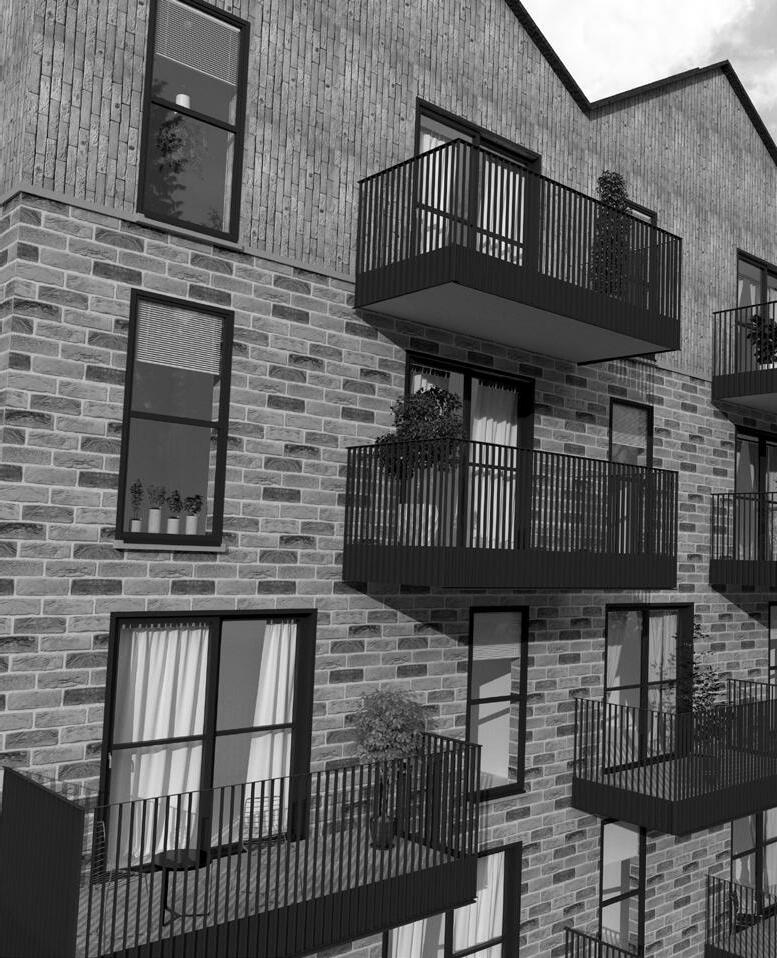







specific Stub-connector



Max 5mm deflection at 2kN point load incorporated in structural calculations.
*Eigenfrequency minimum 5Hz.

Patent pending: Anti-snag slide on technique.





Clamps verified by Balco test facility.
Apertures allow for 20 mm tolerance.
Wallace latch – provides a self-locking function which enables fitters safe access to the balcony.
Certified lifting points
Balustrade connection points







Aluminium alloy: EN-AW 6063-T66 Material classification according EN13501-1:2018 as A1. Rubber gaskets in accordance with exemptions in Regulation 7(3).

Spacer

BS8579: Balconies should not have a perforated pedestrian surface draining directly onto balconies and pubic spaces below without a water collecting surface.
Levitate is fitted with a soffit which manages rainwater through either ’edge’ or ’piped’ drainage systems.
End cap



BS 8579: Where the soffit acts as the principle water collecting surface, it should be set to fall so that it is self-cleansing.
Levitate soffit is always set to a fall of at least 1:80




Referred standards:
BS 6180, Barriers in and about buildings – Code of practice.
BS EN 1990, Eurocode – Basis of structural design.
BS EN 1991 (all parts), Eurocode 1 –Actions on structures.
BS EN 1992 (all parts), Eurocode 2 –Design of concrete structures.
BS EN 1993 (all parts), Eurocode 3 –
Design of steel structures.
BS EN 1994 (all parts), Eurocode
4 – Design of composite steel and concrete structures.
BS EN 1999 (all parts), Eurocode 9 –
Design of aluminium structures.
BS EN 1090 (all parts), Execution of steel and aluminium structures.
NA to BS EN 1990, UK National Annex for Eurocode – Basis of structural design.
NA to BS EN 1991 (all parts), UK National Annex to Eurocode 1.
NA to BS EN 1992 (all parts), UK National Annex to Eurocode 2.
NA to BS EN 1993 (all parts), UK National Annex to Eurocode 3.
NA to BS EN 1999 (all parts), UK National Annex to Eurocode 9.
PD 6688-1-4, Background information to the National Annex to BS EN 1991-1-4 and additional guidance.
Balconies, terraces and access decks should be designed to provide amenity and sized for intended use.
Design should aim for quality and functionality.
Design of balconies, guarding and weather screens should mitigate nuisance effects from wind
Consideration should be given to tie-down points.
Increased wind loading from any higher balustrade/screen
Net wind pressure factors.
X = Used in structural calculations
X
Scope Requirement None Requirement
None Circular holes ≤ 10mm.
Balcony should not screen off intended view.
50% view through balustrade.
Thermal break to reduce heat loss and avoid condensation.
Suitability in terms of tolerances, camber etc.
Accounting for low rotational spring in thermal break connectors.
Design should be according BS standards:
• BS 6180, Barriers in and about buildings – Code of practice.
• BS EN 1990, Eurocode – Basis of structural design.
• BS EN 1991 (all parts), Eurocode 1 –Actions on structures.
• BS EN 1992 (all parts), Eurocode 2 –Design of concrete structures.
• BS EN 1993 (all parts), Eurocode 3 –Design of steel structures.
• BS EN 1994 (all parts), Eurocode 4 – Design of composite steel and concrete structures.
• BS EN 1995 (all parts), Eurocode 5 –
Design of timber structures.
• BS EN 1999 (all parts), Eurocode 9 –
Design of aluminium structures.
No circular holes in any decking type.
Different balustrade designs are available.
As above
Thermal break pads or thermal break connectors are used.
Accounted for in Levitate balcony design phase.
Incorporated in Levitate structural calculations.
All Levitate and balustrade structural calculations are performed according listed standards, including UK National annexes and NCCIs where available.
Glass design in balustrade is confirmed by testing.
Service life equal to buildings primary structure.
Pedestrian surface and balustrade infill 30 years.
Components disproportionately difficult or impracticable to inspect or repair should have service life as designated primary components .
All other balcony components should be designated as secondary components and should be easy to inspect .
Safe method to replace secondary components should be demonstrated in the design.
Assessment of water ingress to interlayer in laminated glass.
Capping should be made to susceptible interlayers.
Base channels should include drainage.
Balconies should be designed to provide equal utility and enjoyments for all users.
Threshold should be designed to minimum restriction or trip hazard.
The threshold of this door should be level from indoor FFL to balcony FFL.
Transition surfaces should fulfill: a) Internal transition max slope 15°, max length 150mm. b) Threshold upstand <15mm and trough minimized.
If drain-type pedestrian surface, finishes should make sure risk for entrapment is removed.
Slots max 8mm wide due risk of entrapment.
Levitate is available in standard sizes
tile patterns of 3x6 up to 5x12.
Aludecking is available in sizes in between as well.
is CE and UKCA marked.
Different balustrade designs available, also including wind screens. Levitate is secured by steel clamps and safety latch.
Object specific structural design in case of high screens.
Wind pressure coefficients according eurocode are incorporated in Levitate and balustrade structural calculations. Not according Figure 5.
Design life of Levitate balcony main structural components 60 years.
For Levitate: Concrete tiles according EN1339:2003 or painted aluminium decking. Balustrade infills durability similar to balcony main structure.
Design life of Levitate balcony main structural components 60 years.
Secondary components are easily inspected, as it is possible to disassemble the product into modules.
Secondary components are easily replaced, as these belong to subassemblies of the final product.
Considered in balustrade design.
Considered in balustrade design.
Considered in balustrade design.
Balcony levelled to 10mm below indoor FFL.
Threshold maximum 4mm above general balcony FFL.
Bespoke stub connectors for levelling of the balcony pedestrian surface.
Bespoke stub connectors for levelling of the balcony pedestrian surface.
See below.
Nominal gap of 1mm between concrete tiles. Aludecking nominal gap 6mm.
• BS EN 1090 (all parts), Execution of steel and aluminium structures.
• BS EN 16612, Glass in building – Determination of the lateral load resistance of glass panes by calculation.
• IStructE, Structural use of glass in buildings [N1].
Both Ultimate and Serviceability combinations need to be considered.
Movements and deflections restricted.
Deflection max 5mm at 2kN static load.
Vertical Eigen frequency minimum 5Hz.
a) Loading of structure
- Walking surface should not be dislodging by wind, flotation or humans
b) Loading of envelope/guarding c) Prevention of falls.
Prevent both people and objects.
Non-climbable, also between balconies.
Terraces, balconies and Juliet guardings 1100mm high above pedestrian surface or FFL.
Toe hold <25mm.
Risk assessment or design incorporating a toe hold should trigger height to 1100mm above step.
Toe hold 300-600mm require increased guarding heights.
Protection from wind.
Mitigate risk for vertigo.
d) Slip prevention.
- Rz > 20µm
- BS7976
- Max 3mm steps on pedestrian surface.
e) Safety for persons below.
- Prevention of falling objects.
- Handrail top surface non-level.
- Brittle materials prevented from falling down.
- Prevent liquids
Incorporated in structural calculations.
Incorporated in structural calculations. Incorporated in structural calculations. Incorporated in structural calculations.
These aspects are handled by:
a) Structural calculations
- Heavy tiles, Aludecking screwed to frame
b) Structural calculations
c) Balustrade
Balustrade according BS6180
Balustrade according BS6180. Screens at adjoining balconies.
Safety height 1100mm in balustrade design.
Steel balustrade have a thin side cover plate / flashing. Narrow aluminium profiles in balustrades.
1100mm is always safety height in balustrade design.
- Increase height to 700mm above toe hold (at least 1100mm above pedestrian surface).
- Architects responsibility (Different balustrade designs are available).
- Higher balustrade available. Handrail provided on balustrade.
Concrete tiles provide slip resistant surface.
- Profiled aludecking. Concrete surface.
- Aludecking paint with properties certified according BS7976-2+A1:2013.
- Even thicknesses on tiles and decking profiles respectively.
Following BS6180 for balustrades.
- Toe board included in balcony side cover plates.
- Either slanted 15degrees or rounded handrails available
- Concrete tiles always on top of metal sheet soffit.
- Drainage through soffit
Performance in fire – General
Materials and components for balconies in respect to fire.
Weathering and hydraulic design.
General
Drainage of balconies and small terraces.
Aspects for safety Requirement
- Prevent dislodging
f) Safety for service.
- Avoid work under suspended load and work at height.
- Cleaning of guarding inside.
- Access to inspect support structure, drainage and paint.
- Cleaning with rope access.
- Rope access connection points.
- Abseil connection points.
No additional risk to building or adjacent building.
Components exposed to fire should:
a) Not provide a medium for fire spread due to material or design.
b) Not propagate fire downwards through falling objects.
c) Be designed to remain in place (no risk for firefighters or the public)
d) Designed to not affect buildings stability when large deformations occur
Open balconies not for access paths do not require fireproof design if size is small enough.
Access balconies and escape routes classed as floor which require fire resistance from underside.
Components of balconies with floor level 11m above ground should be of material class A1 or A2-s1,d0 according BS EN 13501-1:2018. This applies also to all stacked balconies.
All other buildings should have risk assessed to prove adequate resistance. Minor components exempt from requirement according national regulations.
Guardings to access balconies imperforate.
Open structures and open pedestrian surface should be fitted with imperforate tray to reduce risk of fire spread.
Drainage pipe through soffit to be evaluated on risk for fire spreading.
Design should take the following into account:
- Rainwater outlet design
- Overflow design
Controlled drainage should be used to prevent water ingress and staining of the building and/or nuisance to people or landscaping below.
Pedestrian surface should not have free standing water or give rise to water ingress of the building via accessible threshold.
As-built gaps between planks/slabs should be between 6-8mm to achieve effective drainage and minimize discomfort to wheelchair users.
Gaps of 10-12mm around perimeter.
Balconies should not drain through perforations directly on balconies or public spaces below without a water collecting surface.
For balconies with upstands on all sides, water collecting surface can be designed falls or flat with no back falls or ponding.
The design of support structure for water collecting surface should include tolerances and deflections to ensure falls.
If collecting surface is flat, then screed, layer, filler should be used to ensure no ponding occurs. Structural analysis should be used to estimate movements in order to verify drainage.
Balconies and terraces guide for tiles in BS5385-3.
These aspects are handled by:
- Screwed connections to balcony frame.
- Levitate features a locking device which enables secure work.
- O&M
- Possible to lift tiles/unscrew profiles
- Not allowed according current design.
- Not featured in Levitate
- Not featured in Levitate
Non-combustible materials
Non-combustible materials
Load-bearing structure designed for R30 according external fire curve.
Locking mechanism featured.
Levitate have no vertical connections, hence no destabilizing loads other than regular ULS and SLS. Large deflections do not cause any problem, since there are a lot of space below balconies.
Levitate is for single dwelling units only.
Levitate is not intended as access balcony.
Levitate act as Single units (not stacked). Steel and Aluminium classified as A1 materials.
Levitate is non-combustible. If customer requires solution with other materials a risk assessment may be performed.
Different solutions available e.g. aluminium sheet.
Drainage soffit serve as fire protection.
Non-combustible materials used, except sealant but volume used is negligible.
- Levitate options: Piped drainage or Edge drainage.
- Free edge overflow
Levitate have two options: Piped drainage and Edge drainage.
Levitate have decking options with concrete tiles and aluminium flooring, both with porosities for drainage.
Thresholds (balcony extensions against facade) can have the same flooring as slab, with drainage connected to slab drainage.
Nominal distance between tiles: 3mm (as casted).
Nominal distance at perimeter: 2mm.
Levitate is fitted with a soffit which handle the drained water.
Levitate is designed with porous pedestrian surface with a sloping soffit (1:60) that directs the water.
Fixed slope of the soffit ensures the fall and eliminate ponding.
Soffit is always sloping. Deflections are included in structural calculation pack.
BS5385-3 is for tiles in grouting, not applicable to Levitate.
Prevention of water ingress into the building.
Managing water drainage.
Aspects for safety
Require piped drainage and BS6229 should be followed.
a) Water collecting surface 75mm below ingress level.
b) Spillover at least 25mm below ingress level.
c) Water collecting surface nominal 25±10mm below spillover level.
Blocked outlet require an overflow to prevent water from entering the building.
Warning pipe should be provided where flow from overflow is hidden.
When water collecting surface does not coincide with deck level, design should enable inspection and maintenance.
Soffits should be ventilated.
Soffit should be set to falls when used as water collecting surface.
These aspects are handled by:
Not applicable to single Levitate. Large, coupled balconies can be equipped with piped drainage.
Levitate’s soffit is placed at the underside.
Spillover (free edge drain) close to soffit level.
Spillover 20mm above soffit’s water collecting surface.
Overflow at edge drainage of soffit.
Overflow is visible.
Both tiles and aludecking is possible to dismantle.
Levitate soffit is ventilated.
Levitate soffit is always set to falls (1:60).
1:60 is used on the soffit.
Edge drainage of balconies and small terraces.
a) Falls at least 1:80, for on-site built balconies, 1:60 to 1:40 is recommended.
b) Water collecting surface projection 30mm beyond vertical surface.
c) Drain via edge furthest from the wall. At adjacent walls, no discharge within 400mm from wall.
d) Flow concentrations should be avoided.
e) Edge drain allowed if plan depth collecting surface never more than 2500mm.
g) Collecting surface allows drainage from window sills but not roofs or other balconies.
NOTE 1: balconies below 6m2 may omit gutter and rainwater pipes. e) gives a limit for drain length /area for an even outflow.
NOTE 2: Gutters and rainwater pipes may be omitted from tall structures. Such runoff should be directed.
Drainage of soffit through and edge drain profile, extending more than 30mm from balustrade front plane.
Exit slots in edge drain profile are avoided within 400mm from the wall.
Exit slots evenly distributed over the length of the edge profile.
Max depth is 5 tiles (ca 2000mm)
Window sills are allowed to drain on Levitate.
Levitate always fulfill limit in e), but also have the possibility to divide large balconies into more slabs.
It is possible to direct the runoff by soffit and edge profile configurations.
Possible to accomplish with Levitate.
Vertically stacked pipes should fully extend down to the receiving outlet. Outlets accessible and incorporate removable grating.
Outlets should be slightly recessed to avoid ponding.
Tiles and aludecking removable.
Outlet is fitted to a drainage profile.
• CE/UKCA marked according EN1090, EXC2.
• 60 year design life.
• Structural calculations for ultimate resistance as well as deflections at serviceability limit state.
• Max 5mm defection at 2kN point load incorporated in structural calculations.
• Eigenfrequency minimum 5Hz.
• BS8579 compliant.
• Compliant with Approved Document B: Regulation 7.
Levitate and balustrade structural calculations are performed according relevant BS standards, including national annexes and NCCI’s, such as:
• BS 8579:2020, Guide to the design of balconies and terraces.
• BS 6180, Barriers in and about buildings – Code of practice.
• BS EN 1990, Eurocode – Basis of structural design.
• BS EN 1991 (all parts), Eurocode 1 – Actions on structures.
• BS EN 1992 (all parts), Eurocode 2 – Design of concrete structures.
• BS EN 1993 (all parts), Eurocode 3 – Design of steel structures.
• BS EN 1999 (all parts), Eurocode 9 – Design of aluminium structures.
• BS EN 1090 (all parts), Execution of steel and aluminium structures.
Balco ownes over 40 patents which make our products unique within our industry.
Every year the global agency Dun & Bradstreet performs a credit assessment of multiple companies. Over the last ten years we have achieved the highest credit rating –AAA.

Our ISO 9001 certification gives our customers assurance that Balco’s products are produced in accordance with high quality standards and in an environmentally responsible manner.

SMAS Worksafe is one of the UK’s leading providers of health and safety assessments and a national leader in providing full form SSIP (Safety Schemes in Procurement).

CHAS is the UK’s leading provider of compliance and risk management solutions.A co-founder of Safety Schemes in Procurement (SSIP) and the Common Assessment Standard
Constructionline has been working with construction buyers and suppliers for over 20 years to develop a deep understanding of buyers’ needs. Constructionline prides itself on opening up opportunities for members to access a wide range of procurement contracts and projects – and for buyers to access a validated pool of high quality suppliers.
